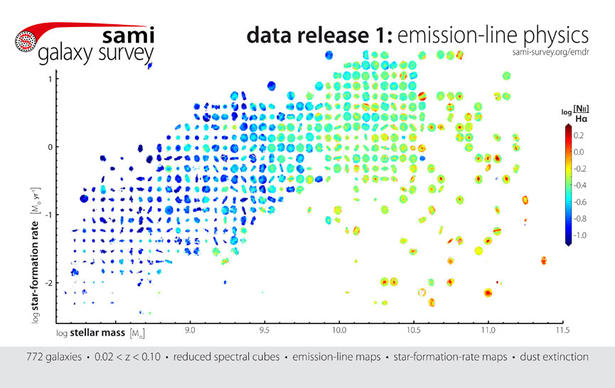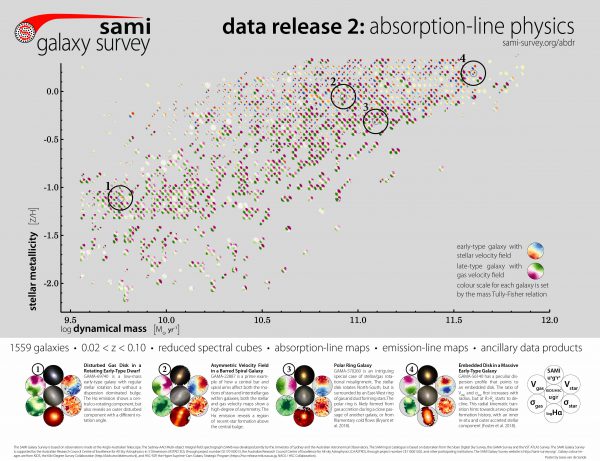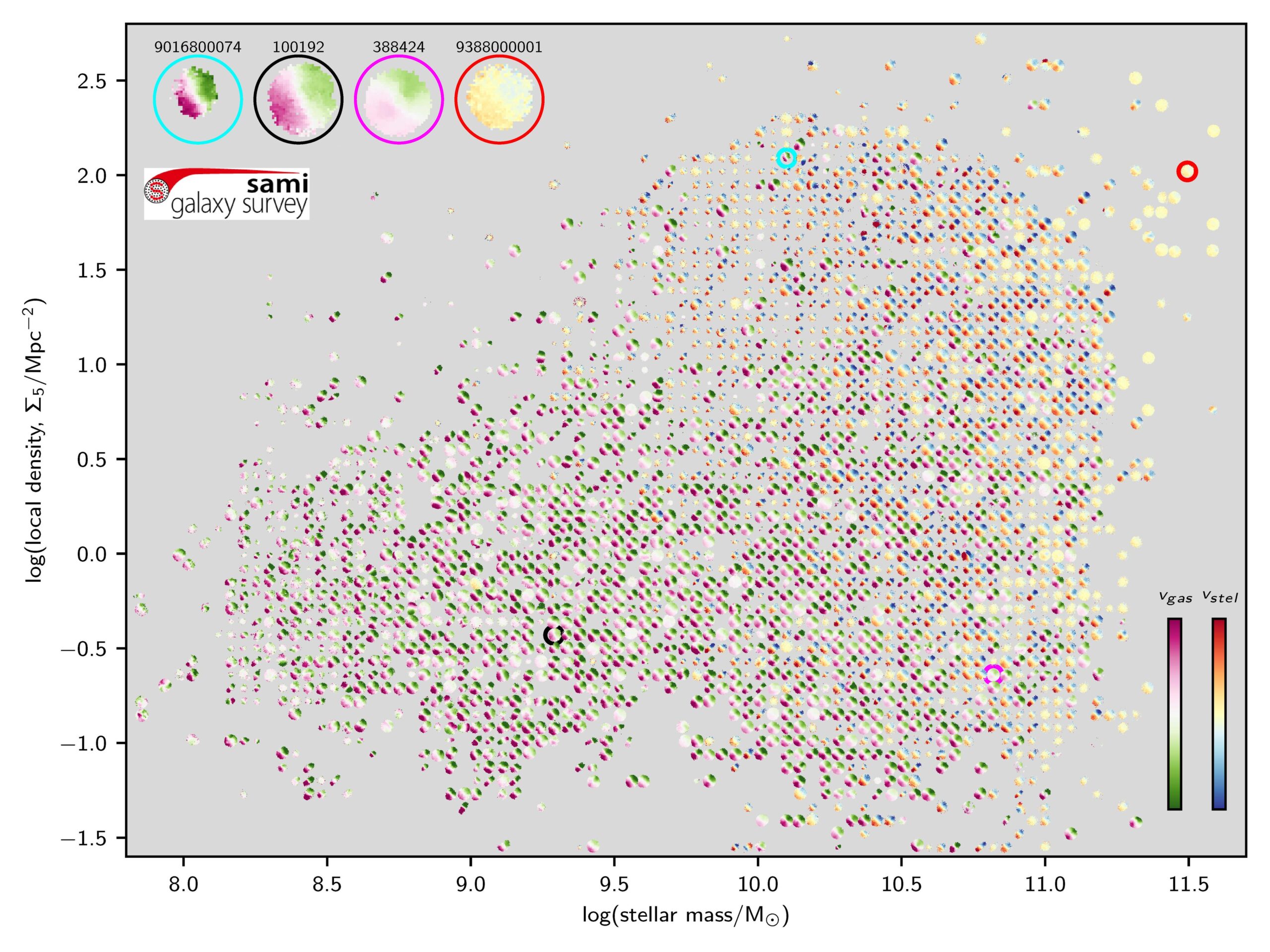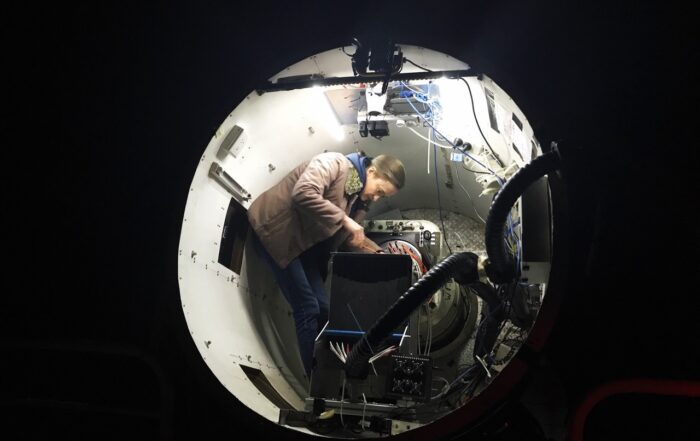The data for the SAMI Galaxy Survey is being collected using SAMI, the Sydney-Australian-Astronomical-Observatory Multi-object Integral-Field Spectrograph. The SAMI instrument was on the 4-meter Anglo-Australian Telescope at Siding Spring Observatory. Integral-field spectroscopy (IFS) allows a unique “3D” view of how stars and gas zoom around inside distant galaxies because we collect dozens of spectra across the entire face of each galaxy, which not only tells us what the stars are made of in the galaxy, but also whether the stars and gas are moving towards us or away from us.
The SAMI Galaxy Survey began in March 2013 and has just completed collecting spectra of 3068 galaxies across a large range of environments.
The key science goals of the SAMI Survey are to answer the following questions:
- What is the physical role of environment in galaxy evolution?
- What is the relationship between stellar mass growth (stars forming and evolving) and angular momentum development (motion of stars, gas and dark matter) in galaxies?
- How does gas get into and out of galaxies, and how does this drive star formation?
The Hector instrument will replace SAMI – increasing the power of SAMI in terms of the spectral resolution, spatial sampling and galaxy number. Hector will be commissioned on the Anglo-Australian Telescope (AAT) at the end of 2020. The combination of SAMI/Hector and the ASKAP Surveys will track how and where galaxies build their matter and angular momentum, as well as how the chemical elements are spread across galaxies.
The SAMI Survey
The SAMI Survey is the first 3D spectroscopy sample that is sufficiently large to disentangle the competing roles of galaxy mass and environment. As a result, the team can address the following three questions:
- What is the physical role of environment in galaxy evolution?
- What is the interplay between gas flows and galaxy evolution?
- How are mass and angular momentum built up in galaxies.
The Hector instrument
Hector is the next major dark-time instrument for the AAT and is a multi integral-field-unit spectrograph aimed at obtaining a low-redshift galaxy survey of up to 30,000 galaxies, with 90% imaged out to 2 effective radii.
Hector will decipher the diversity of galaxies through understanding the physical basis for their individuality.
The key science questions for this instrument include:
- how do galaxies build up mass and angular momentum?
- how is star formation and nuclear activity affected by environment?
- what is the role of feedback, and how does large-scale environment modulate galaxy growth through tidal torques and gas accretion?
A new, innovative robotic system will position magnets across the field plate which will rotate the hexabundles in 3 axes to match telecentricity and ferule positioning, which will improve throughput over the existing 2dF facility. Observers will put the configured plate onto the telescope and attach the 21 hexabundles. One plate can be being configured by the robot while another is observing.
SAMI/HECTOR LEADERSHIP
latest in Sami/hector
Galaxies get more chaotic as they age
Age is the driving force in changing how stars move within galaxies. An international team led by Australian research centre ASTRO 3D reports that age is the driving force in changing how stars move [...]
Spin flips show how galaxies grow from the cosmic web
The alignment between galaxy spins and the large-scale structure of the universe reveals the processes by which different components of galaxies form. Like our own Milky Way, most galaxies have two components: an extended [...]
SAMI Maps Our Nearby Universe
Our Monthly Media for June comes from Dr Sam Vaughan, from our University of Sydney node, on the final data release from the SAMI galaxy survey led by Professor Scott Croom, also at the University [...]
The secrets of 3000 galaxies laid bare
A/Prof Julia Bryant from the University of Sydney inside the SAMI instrument at the top end of the Anglo Australian Telescope Credit: Scott Croom/University of Sydney Completion of Australian-led astronomy [...]
Q&ARC Conversations with Researchers from ASTRO 3D
ASTRO 3D jumped on the collaborative Australian Research Council's Centre of Excellence social media video series "Q&ARC" bandwagon. Q&ARC Conversations with CoE Researchers takes you to leading [...]












